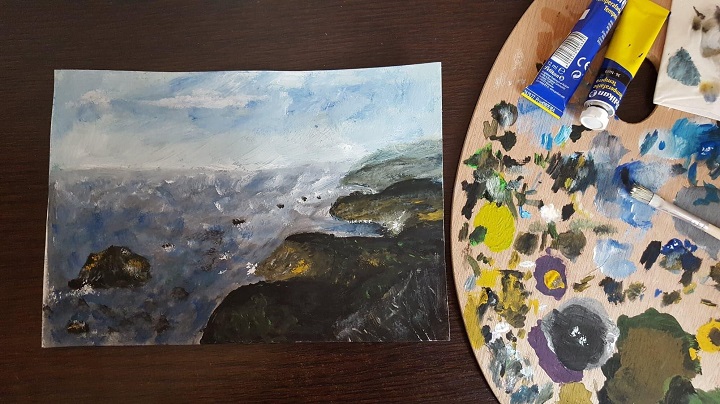Painting is not just for professionals, you can do it as a hobby if it makes you feel good and satisfied by just doing it. There’s nothing wrong with just being an amateur at painting. In fact, the word “amateur” was derived from the Latin word “amator” which means “someone who loves”.
Painting can stimulate your imagination and inspire you to explore how your mind interprets the world. It can be used as a way to pour your thoughts and feelings on canvas and create something exquisitely beautiful. If you’re a beginner, you’re probably not sure which art supplies exactly you will need to continue this journey of exploring your artistic side. Worry not, we’re here to suggest you which art materials you should look for in a well-supplied arts and crafts store.

Painting surface
Any surface that can hold up a little moisture, can be used to create a creative piece of artwork. Canvas is one of the most popular choices. It’s lightweight, easily portable and has a pleasing receptivity to the brush. Its longevity also plays a big role in its great popularity. If you want to create a permanent artwork that will last for centuries, canvas is the ideal choice. You can draw on canvas either with oils or acrylics, plus, it works well with different texture mediums and embellishments.
Hardwood panels are also used to create permanent art. They can be used with heavy applications of texture medium, gesso or paint that add extra texture and weight to the painting as they are usually made from hardwoods like oak, mahogany and walnut. Therefore, they can be very heavy and that’s why they’re less popular and artists tend to choose canvas over wood surfaces.
Paper is another surface commonly used for painting, which can be found in different types. It’s is generally much thinner than canvas and doesn’t hold up well to multiple layers and heavy textures. However, there are different types of papers for painting, such as canvas paper, watercolour paper, bristol paper, etc.

Paintbrushes
Brushes are the heart of every painter’s toolkit. There is a wide selection of paintbrushes you can find in any physical or online arts and crafts store. They come in many different shapes and sizes. Your choice will mainly depend on how detailed you want to get. There are 8 main types of paintbrushes.
● Round – round tip; good for sketching, outlining, detailed work, filling in small areas;
● Pointed round – narrow and with a sharply pointed tip; good for fine details and lines, delicate areas, spotting and retouching;
● Flat – square end, with medium to long hairs; good for bold strokes, filling wide spaces, washes, impasto;
● Bright – flat with edges curved inward at the tip, short hairs; good for short controlled strokes;
● Angular flat – flat with angled hairs at the end; good for curved strokes and filling corners;
● Detail round – round, hairs shorter in length, shorter handle; good for details and short strokes;
● Filbert – flat and oval-shaped end with medium to long hairs; good for blending;
● Fan – flat, spread (natural) hair; good for smoothing, blending and feathering.

Source: Skillshare
Paints
Acrylic paints are one of the most commonly used among artists. They are ideal for fine brushwork, glazing, staining, water media techniques etc. They attach to most bases: canvas, wood, watercolour paper, metal, etc. and dry very fast.
Another paint type is watercolour, which is a translucent paint containing pigment and a binder, typically gum-arabic. The paint has a colour pigment that’s suspended in water until the water dries.
Tempera is also popular among artists. It is not permanent, but it’s not so easy to wash off. Its opacity is the best out of all paint types. It has a creamy consistency, mixes very well, it is thinner and more liquid than acrylic, and it dries matte. Tempera is best used on paper.

Coloured Pencils
Coloured pencils are a beautiful dynamic medium which is very easy to use and it’s a lot cleaner in comparison with other art mediums. No wonder why artists and hobbyists love them. They are so popular because they’re capable of rendering art styles that are expressive and abstract, or detailed and photorealistic. When using it, the artist has great control and can be more specific with details. The versatility of coloured pencils also allows the application of bold, opaque colours, either by pressing harder or by layering and blending. They’re also practical, light and portable, so you can travel with them and draw on location. In terms of types, coloured pencils can be soft and hard.
Other Accessories
▪ One of the most essential art materials is the easel – an upright frame, typically on three legs, used for displaying or supporting canvas. There are 10 types of easels, each with a slightly different purpose.
▪ Palettes are another art accessory that you should look for in an arts and crafts shop. This is the surface on which you squeeze out and mix the paint.
▪ Painting knives – These are commonly used in acrylic painting for mixing paint or for applying thick, textured paint directly on the canvas.